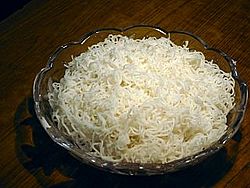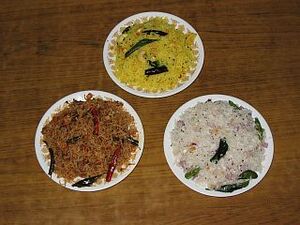Sevai facts for kids

Freshly extruded sevai
|
|
| Alternative names | Shavige |
|---|---|
| Type | Rice noodle/rice vermicelli |
| Place of origin | India |
| Main ingredients | Rice |
| Variations | Santhakai |
Sevai is a yummy type of rice vermicelli (which are like thin noodles) that's super popular in India. You might also hear it called shavige, saemia, or santhakai. Even though it's usually made from rice, you can also find sevai made from other grains like wheat or ragi (a type of millet).
The History of Sevai
Did you know sevai has a long history? Food experts say that writings from ancient Sangam literature (around the 1st century AD) talk about sevai and a similar dish called idiyappam. A cookbook from 1025 CE, called Lokopakara, even describes how to make sevai and the special press used for it!
How Sevai is Made
Sevai is often made fresh right from rice grains. But you can also find dried sevai packs, sometimes called rice sticks, in Asian grocery stores.
Here's how people traditionally make sevai at home:
- First, parboiled rice is soaked in cold water for about three hours.
- Next, the soaked rice is ground into a smooth paste using a special wet grinder.
- Then, small dumplings are made from this rice paste and steamed until cooked.
- Finally, these cooked dumplings are pressed into thin strands using a sevai press.
What's in Sevai?
Homemade sevai is usually made from 100% rice, plus water and a little salt. However, the dried rice sticks you buy might have other things added, like tapioca or corn starch.
In some parts of Karnataka, a region in India, shyaavige (another name for sevai) is made from different grains. This changes how thick the noodles are. For example, sevai made with ragi or millet is usually thicker. But if it's made with rice or wheat, the strands are much thinner.
Sevai can be a sweet treat or a savory meal. When it's a dessert, it's often made like a kheer (a creamy pudding) with milk, jaggery (a type of unrefined sugar), cardamom, and saffron.
Sevai vs. Idiyappam
Sevai is very similar to idiyappam because they use the same ingredients and are made in similar ways. But there's a key difference! Sevai is usually broken up or cut into smaller pieces, almost like a substitute for rice. Idiyappam, on the other hand, is often served in neat piles of noodles with side dishes like curries.
The presses used to make both sevai and idiyappam are pretty much the same. Unlike idiyappam, sevai is usually not served with curries. Instead, it's mixed with yummy flavors like lemon, tamarind paste, coconut, or uddina pudi (a powder made from black gram dal in Karnataka). When called shavige in Karnataka, it can also be mixed with cooked vegetables and spices, often with a splash of lemon juice.
Sevai is a popular breakfast or snack dish in Tamil Nadu and other parts of South India. It can also be a delicious dessert called payasam when cooked in milk with cardamom or other spices and sugar. In the Kongu region of Tamil Nadu, there's a special type called Santhagai, which is even part of wedding traditions!
In the Malnad region of Karnataka, sevai might be served with chicken curry, which is different from how it's usually eaten elsewhere in South India. Some communities, like the Sankethi people, also enjoy idiyappam flavored like sevai, with lemon, tamarind, or uddina pudi. Other types of sevai, made from ragi, jowar, or other grains, are often served plain with sweet coconut milk or different edible powders, including powdered chickpea and sesame. In Tamil Nadu, santhakai is often flavored with lemon, tamarind, tomato, coconut, and curd, and it's usually eaten warm.


